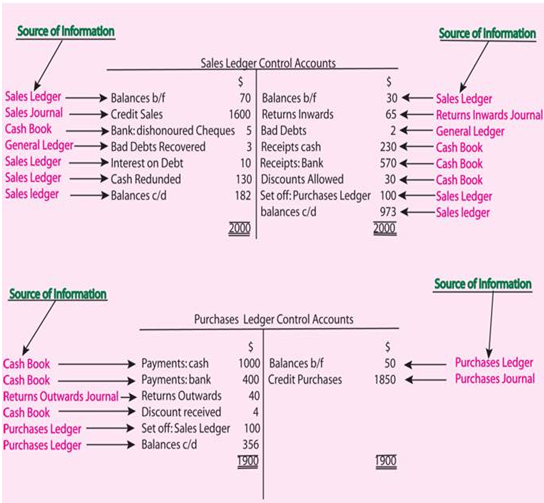Assalamualaikum,
We have actually or currently studying cash book. It is the combination of the cash account and also the bank account. In reality, we don't have cash account coz we will only dealing with petty cash. We will not cover petty cash at the moment, so let's focus on the cash book as it will be a question in your final.
I have already covered most of the topic during my lecture. And here is some notes I took from the net. You as same as me, should always refer to the net because it has so many valuable information that might help you in your study. Since you want to be spoon fed, then I'm not pasting it in my posting.
Definition and Explanation of Cash Book
Definition:
The book in which all cash transactions (either cash is received or paid) are primarily recorded according to dates, is called 'Cash Book'.
Features:
A Cash Book has the following features:
- It plays a dual role. It is both a book of original entry as well as a book of final entry. All cash transactions are primarily recorded in it as soon as they take place; so it is a journal (a book of original entry). On the other hand, the cash aspect of all cash transactions is finally recorded in the Cash Book (no posting in Ledger); so a Cash Book is also a Ledger (a book of final entry).
- Only one aspect of cash transaction is posted to the ledger account. The other aspect ( i.e. cash aspect) needs no posting in Cash A/c. Since the Cash Book is the substitute for Cash A/c, no Cash A/c is opened in the ledger.
- It has two identical sides-left hand side, the debit side and right hand side, the credit side.
- All the items of cash receipts are recorded on the left hand side and all items of cash payments on the right hand side in order of date.
- The difference between the total of two sides shows cash in hand.
- Its balance is verified by counting actual cash in the cash box.
- It always shows debit balance. It can never show credit balance.
Advantages:
Generally cash transactions are numerous. What is credit transaction today, will be cash transactions tomorrow. In other words, all credit transactions are finally settled by cash. If like all other transactions cash transactions are also recorded primarily in Journal, the cash aspect of the transactions will be required to be posted to Cash A/C, in the Ledger separately. This involves much time and labour. This is why, cash transactions are recorded in a separate book named Cash Book. It saves much time and labour. Besides this the Cash Book renders the following benefits:
- Daily cash receipts and cash payments are easily ascertained.
- Cash in hand at any time can easily be ascertained through Cash Book balance.
- Any mistake in the book can be easily detected at the time of verification of cash.
- Any defalcation of money can be detected while verifying cash.
- Since cash is verified daily, Cash Book is always kept up-to-date.
Is Cash Book a Journal or a Ledger?
From the above discussion it appears that the Cash Book is the substitute for the Cash Account. In fact, no separate Cash Account is opened in the Ledger, Cash Book serves the purpose of the Cash Account. The entries in Cash Book are regarded as one aspect of the Double Entry System - the other aspect is posted to the Ledger in the concerned account. L.C. Cropper remarked "Every entry in the Cash Book makes one half of a double entry; the other half of the double entry appears on the opposite side of some account in the Ledger."From this angle, 'Cash Book is a Ledger'.
On the other hand, all cash transactions are primarily recorded in the Cash Book in order of date and thereafter posted to the concerned ledger accounts. Judging from this angle, 'Cash Book is a Journal'. Thus we see that a Cash Book is the 'mixture of Journal and Ledger'. According to Spicer & Pegler, "the Cash Book is actually a ledger account, but owing to the large number of entries made therein, it is kept in a separate book, called a Cash Book, which is used also as a book of prime entry."
Specimen/format of Simple Cash Book:
| Date | Particular | V. No. | L. F. | Amount$ | Date | Particulars | V. No. | L. F. | Amount$ |
| | | | | | | | | |
The Columns of the Cash Book are Explained Below:
1. Date:
The date of transaction is written in this column in two lines—in the first line, the year and in the second line, the name of the month followed by the actual date.
2. Particulars:
In this column the name of the opposite account is written (the second aspect of cash transaction). Below this is written the narration of the transaction.
3. L.F. (Ledger Folio):
The page number of the Ledger where the concerned (opposite ) account has been opened, is written in this column. This will help to locate the account from the Ledger. It may be noted that in a Ledger account J.F. is written as reference, while in a Cash Book L.F. is written. It is so, because cash transactions are not recorded in any Journal.
4. Amount:
The amount of the transaction is recorded in this column. The amount of cash received is recorded on the debit side in amount column and the amount of cash paid is recorded on the credit side in amount column.
5. V. NO. (Voucher Number):
The voucher number of each item of receipt and payment is also written. A voucher is necessary for each item of receipt and payment. Generally, a voucher has a serial number and this number-is written in this column (V. No).
When cash is received from a debtor or customer, generally a receipt or 'cash memo' is issued to the debtor which is called Receipt Voucher. Again, when money is paid to a creditor or supplier a receipt is obtained from him which is called 'Payment Voucher, Cash transactions are recorded in the Cash Book on the basis of Receipt Voucher and Payment Voucher.
Thus, a document evidencing cash receipts and payments and forming the basis for making entries in the Cash Book is called Cash Voucher.
Distinction Between a Cash Book and a Cash Account:
In fact, Cash Book is a substitute for a Cash Account. Yet there are some differences between the two, which are given below:
| Cash Book | Cash Account |
| 1. | It is a separate book in which cash transactions are directly recorded. | 1. | It is an account in a Ledger in which posting is made from journal. |
| 2. | It serves the purpose of both journal and ledger and hence cash transactions need not be primarily recorded in Journal. | 2. | It serves the purpose of a Ledger only. If Cash A/C is opened in the Ledger, all cash transactions are first recorded in journal. |
| 3. | Narration is required. | 3. | Narration is not required. |
| 4. | A column for Ledger Folio is provided. | 4. | A column for Journal Folio is provided. |
Thanks and credits to:
http://www.accountingexplanation.com/definition_and_explanation_of_cash_book.htm


